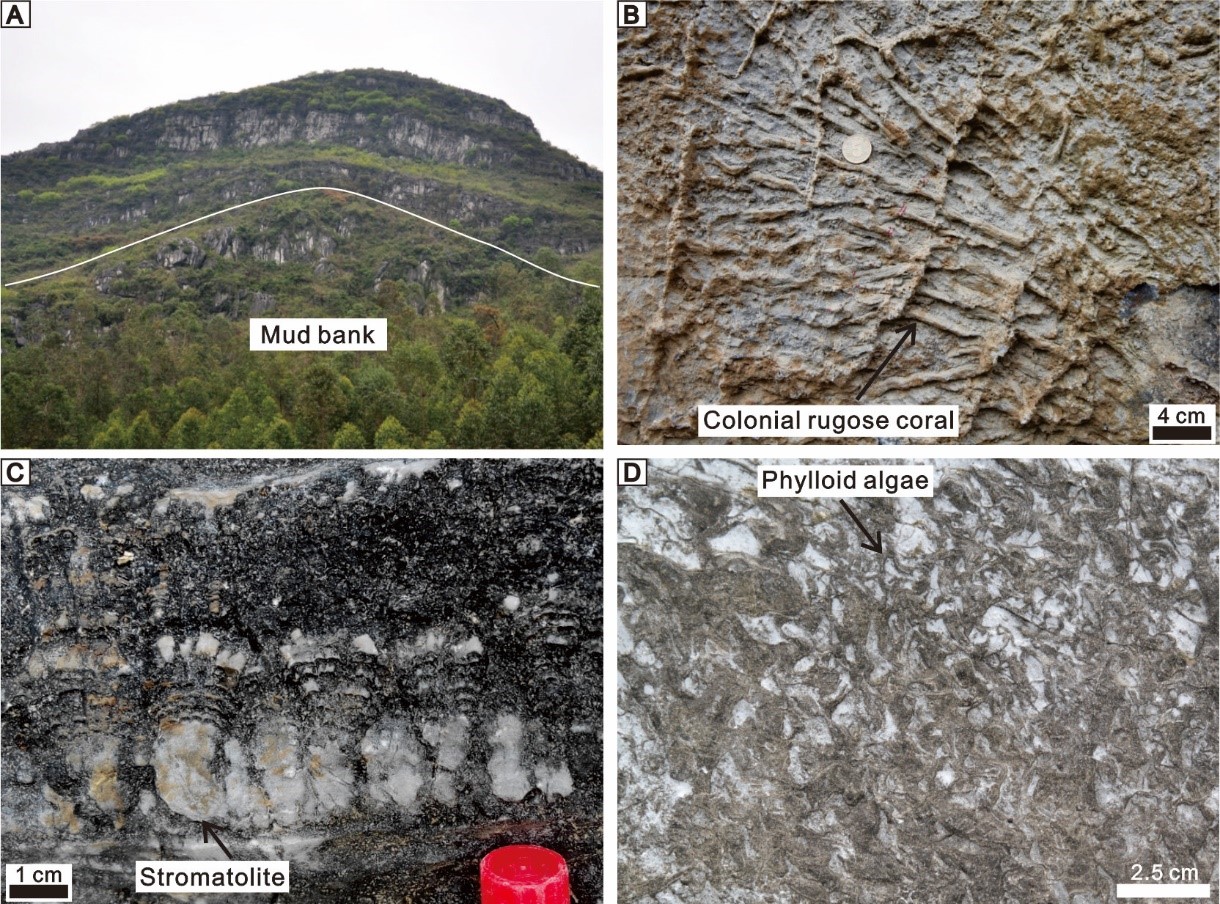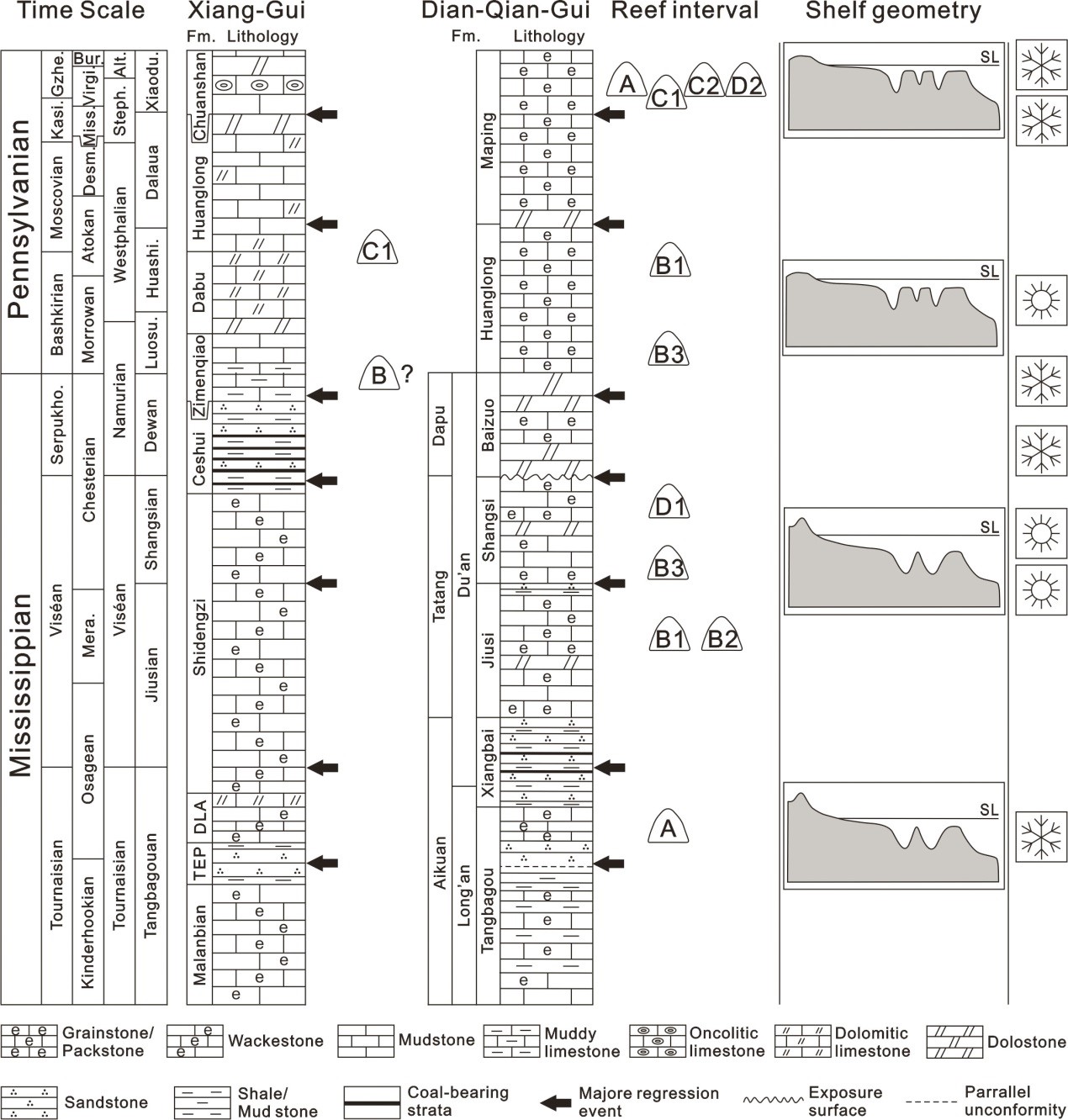Stromatoporoid-coral reef ecosystems have collapsed and disappeared during the Frasnian-Famennian and Hangenberg mass extinction events during the late Devonian and Devonian-Carboniferous transition, respectively. In addition, prominent glacial and interglacial events accompanied by frequent sea-level fluctuations occurred during the Carboniferous. They all have an important influence on the evolution of the Carboniferous reefs. The Devonian and Permian are periods of global reef expansion, while the Carboniferous is a period of global low reef abundance, with a few reef cases documented. To date, it is still unclear about the composition and evolutionary process of the Carboniferous reefs.
Reefs are complex ecosystems and their growth and demise are closely related to changes in the abundance of potential reef-builders, temperature, relative sea level, and palaeogeography. During the Carboniferous, the South China Block was located near the equator, with warm climate and extensively successive carbonate sequence which provide suitable conditions for the development of reefs, and then for the studies on the reef composition and evolution and their relationships to the palaeoenvironmental changes during this time interval.
The published and new data on reefs, main reef-builders (corals, bryozoans, calcareous algae etc.), and palaeoenvironmental proxies (glacial records, sea-level changes etc.) during the Carboniferous were systematically reviewed by Dr. YAO Le and Prof. WANG Xiangdong from Nanjing Institute of Geology and Palaeontology, Chinese Academy of Sciences.
The types, abundance, and distribution of Carboniferous reefs in South China were relatively simple, low and limited, respectively. The reef types mainly include metazoan reef (coral reef/biostrome and bryozoan-coral reef), algal reef (red algal and phylloid algal reefs), microbial reef (stromatolite and Tubiphytes reefs) and carbonate mud mound (Waulsortian carbonate mud bank), which were distributed mainly at the platform or isolated platform margins and slopes in Qian-Gui areas.
In South China, the Carboniferous reefs underwent the evolutionary episodes of the recovery, decline and turnover, which were controlled mainly by reef-builders abundance, sedimentary facies, and relative sea-level changes. Metazoan flourishing, carbonate facies development with relative sea-level rise are in favour of developing metazoan reefs, such as during the Viséan and late Bashkirian-middle Kasimovian times. On the contrary, metazoan decline, non-carbonate facies formation due to relative sea-level fall leads to metazoan reef decrease, as in the Tournaisian and Serpukhovian times.
From the Mississippian to Pennsylvanian, the changes from metazoan reefs into algal reefs are caused primarily by the development of shallow-water carbonate facies that resulted from relative sea-level fall. Although some differences can be recognized in the different time scales, the reef evolution in South China is consistent with that of globe during the Carboniferous. Besides, the transgressive and regressive events in South China correspond to the growing and retreating of Gondwana glaciation. They all suggest that global climate cooling and warming may also influence the reef evolution in South China during this time.
This paper was published in Palaeoworld and financially supported by the National Natural Science Foundation of China and the Ministry of Science and Technology Foundation Project.

Main reef types of the Carboniferous reefs in South China
(A) Carbonate mud mound (Waulsortian carbonate mud bank); (B) Coral reef; (C) Microbial reef (Stromatolite reef mound); (D) Algal reef (Phylloid algae reef)

Overview of lithostratigraphical column with indications of reef intervals, shelf geometry, and climate
A: Carbonate mud mound; B: Metazoan reef; B1: Coral reef; B2: Bryozoan-coral reef; B3: Coral biostrome; C1: Red algae reef; C2: Phylloid algae reef; D1: Stromatolite mound; D2: Tubiphytes reef
Download:
